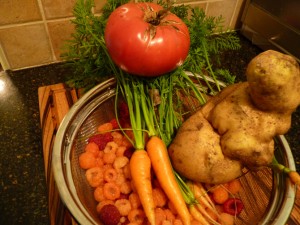Beltane Emergence Moon
Finally the temperature regime has begun to warm, making it safe for the tomatoes, peppers, egg plant, beans, cucumber and tomatillos. We drove to Green Barn this morning to pick up egg plant, tomatillos, blue berry plants, chard and collard greens. They’re already out of kale.
After getting my head straight about the international ag labs recommendations, I put together a batch of transplant water, 3 gallons. Then I poured Jubilate, a microbial inoculant into an old dog dish, tossed the urea in its jar on top and carried all this out to the vegetable garden. To get into the garden I had to step over the copper bird feeder pole I inserted just below the gate’s bottom to keep Rigel out.
Setting those things down I retrieved the tomato and pepper plants from the deck where they have been sitting since coming last Tuesday. Kate’s been taking them out and bringing them in at night since the weather was too chilly for them. Now it’s all good.
Putting two tablespoons of urea (small white pellets) and two tablespoons of Jubilate (a  brownish thick powder) into each hole, I put the midgets, the romas and the Cherokee Purples in their places atop the sun trap. Then, using an old Tide measuring cap, I spooned a pint of transplant water onto each tomato plant.
brownish thick powder) into each hole, I put the midgets, the romas and the Cherokee Purples in their places atop the sun trap. Then, using an old Tide measuring cap, I spooned a pint of transplant water onto each tomato plant.
The peppers went into a raised bed and they received identical treatment except the amounts were one and a half tablespoons instead of two. Then the transplant water.
By that time the sun had come out. It was noon. Having just seen the dermatologist yesterday I decided to stop and return later in the afternoon, when the sun’s angle is more gentle. I want to get all the tender plants, including the beans and peas, planted today. Then we’ll be into maintenance mode for the next two and a half to three months.
Of course, with the international ag lab’s system, maintenance is more intensive than in the past, but that’s fine. The results are worth it.
